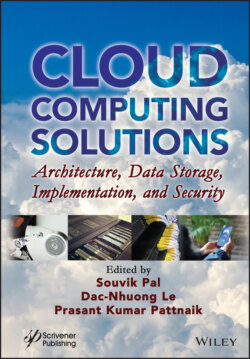Читать книгу Cloud Computing Solutions - Группа авторов - Страница 85
3.2.5.1 Cloud Platform Architecture
ОглавлениеCloud platform architecture is the base architecture of cloud, which includes the cloud service-oriented architecture. In a CPA reference model, we classified the CPA model into the following sublayers:
1 Distributed resources of physical hosts: Resources of physical hosts are distributed over the lowest level of the framework. These resources are logically represented as a multiple numbers of virtual machines (VMs) through resource virtualization. Resources are basically a pool of processors, memory, CPU cores, storage, networking components, etc. All those resources are efficiently provisioned to the cloud users through virtualization technique. Resources virtualization is discussed in the fourth layer.
2 Cloud hypervisor: Cloud hypervisor is designed like a mainframe operating system that allows other operating systems to run on the same machine concurrently. It monitors the access of guest operating systems (users’ operating systems). Hypervisor monitoring environment (HME) administrates the system by letting the guest node enter the system and handle the memory management of the VMs, e.g., VMware, Hyper-V, KMV, Xen.
3 Resources virtualization: The concept of virtualization is the most important basic sub-block of the cloud framework. Virtualization is the process by which we can hide the underlying infrastructure by inserting a logical layer. The three basic resources, i.e., computation, network and storage, are virtualized and represented logically in this layer. Resource virtualization can be considered as the most important layer of the cloud stack. Resource virtualization is that which mainly deals with network, storage and computation virtualization. The basic concept of virtualization is to hide underlying infrastructure by creating a logical interface which helps customers deploy their application onto their respective VMs and also makes provisioning the resources to users easier. We will elaborately discuss different types of virtualization in the next chapter.
4 Virtual machines (VMs): These are the abstraction level of real host machines and each VM is dedicated to each application. Multiple numbers of virtual machines are there to support multiple operating system and application instances. These VMs provide greater scalability, flexibility, and better performance. The details of VMs are presented in the subsequent chapter.
5 Distributed service assurance platform: This platform helps to create FCAPS (Fault, Configuration, Account, Performance, Security) virtual servers [6] that allow hosting the operating systems and executing the applications. It provides dynamic service, accounting, and performance optimization, enabling security and updating configuration. Creation of FCAPS virtual servers provide automated mediation services to ensure better performance, reliability and fault management.Automated mediation service is that which provides the capability to compose logical virtual servers which assures Quality of Service (QoS) and proper resource provisioning. Cloud service providers offer these virtual machines or the virtual servers including proper management API (application programming interface) component to the developers so that they can easily develop self-optimized and self-configured business services.
6 Software-oriented service: This module provides ready-to-use software service. The end users do not incur any overhead for purchasing and maintaining the software.
